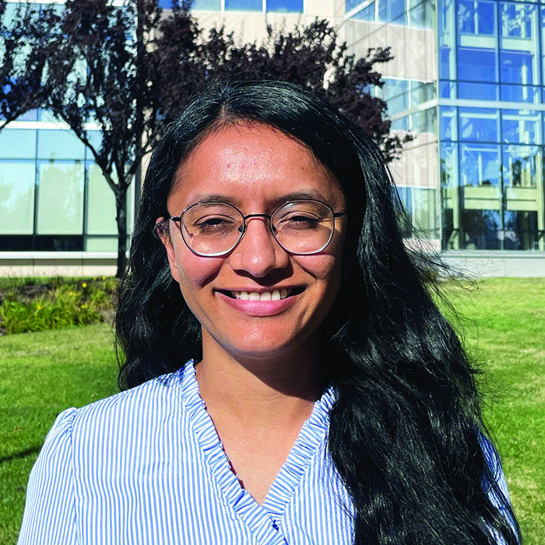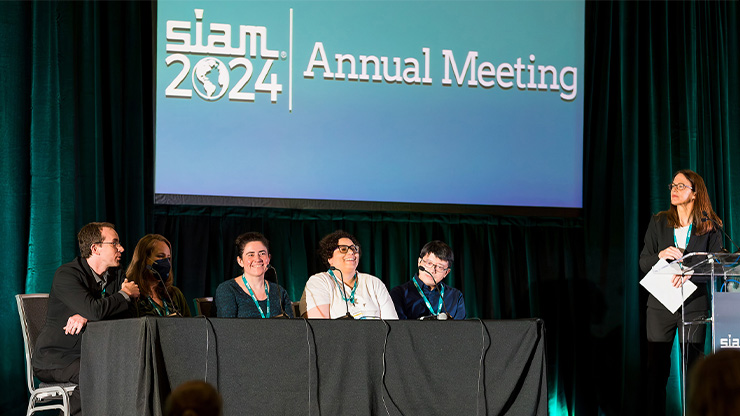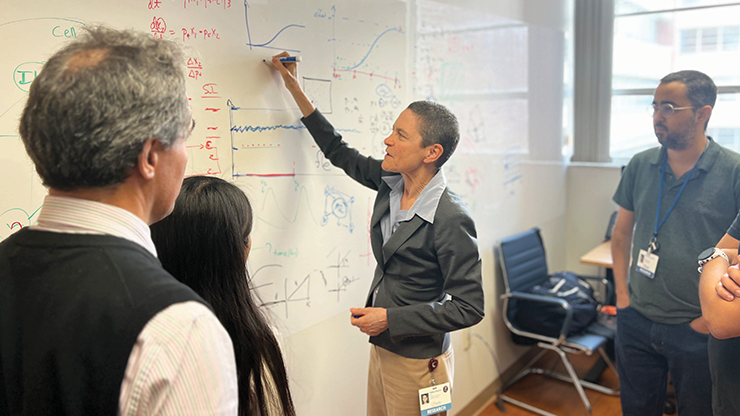Finding My Passion: A Mathematical Journey from Academia to Industry
Like many other students, I had a complicated relationship with mathematics in my elementary and middle school years. In high school, however, I began to develop an aptitude for the subject with the help of a couple of teachers who dramatically changed my perspective. I started to view mathematics as a subject of logic and reasoning, rather than a mere set of abstract concepts. Therefore, my decision to pursue a B.S. in mathematics from the Maharaja Sayajirao University of Baroda in India came naturally. Unfortunately, the basic sciences—unlike engineering and medicine—were not popular areas of study among my peers because they provided limited career opportunities within India at the time. As a result, there was very little societal awareness of the varied career pathways that the basic sciences could offer beyond academia. Nevertheless, the support of my parents motivated me to carve my own path and find a career that centered on my passion for mathematics.
My undergraduate courses allowed me to explore the diversity of mathematics and better understand math as a language with which to interpret the world. I marveled at the beauty of mathematics and its significance in various areas of study, including the use of optimization in operations research, cryptography’s relevance to debit cards, and the application of linear algebra in many aspects of physics and engineering. During these college years, I also began to appreciate both the connections and distinctions between pure and applied math. I ultimately determined that I was more drawn towards applied mathematics, as I wanted to specifically work on real-world problems. Having narrowed my interest, I decided to seek an M.S. in applied mathematics from my undergraduate institution.
In the initial year of my continuing studies, I secured the first rank in my class; doing so enabled me to pursue a specialization in industrial mathematics that, in hindsight, became a pivotal milestone in my career path. As part of this track, I studied a unique set of subjects—such as fuzzy logic, wavelets, and finite volume analysis—that are commonplace in multiple industrial organizations. The curriculum also involved hands-on projects in a variety of real-world engineering disciplines, from flood prediction (civil engineering) to temperature distribution in power transformers (electrical engineering). These invaluable experiences revealed the magnificence of computational mathematics within the context of engineering. At the culmination of my master’s degree, I felt that I had fulfilled at least part of my quest by solidifying my interest in computational mathematics within engineering settings. However, a long expedition stretched ahead during which I had to build a research skillset and discern career options in this area.

The next step was a Ph.D. My sister, who had moved to the U.S. to advance her own career, told me that a Ph.D. from a U.S. institution would offer me the necessary qualifications to succeed. As I began to prepare for the move, I also took some time to explore several teaching opportunities. I served as an assistant professor at the Sardar Vallabhbhai Patel Institute of Technology in India and later worked as a visiting lecturer at my alma mater. Regardless of one’s position, I believe that teaching is an integral part of a career trajectory; it strengthens existing skills and aids in the effective communication of ideas and concepts. I therefore view all of my teaching experiences—including my time as a teaching assistant during my Ph.D.—as essential components of my professional journey.
Upon arriving in the U.S. to pursue my Ph.D. at the University of Texas at Dallas, I was committed to learning more about the art of problem solving. I was instantly drawn to the work of my advisor, John Zweck, who studies nonlinear optical dynamical systems and their varied applications in medicine, astronomy, and optics. I jumped at the opportunity to perform my dissertation research under his guidance, as it seemed to perfectly align with my mathematical interests and had motivating real-world applications. My dissertation used adjoint-state optimization to numerically compute periodically stationary pulses in a short pulse laser and investigate their stability. My Ph.D. was certainly a comprehensive experience in that I acquired technical skills but also developed important research attributes such as patience, curiosity, organization, and analytical thinking.
As my educational crusade drew to a close and my professional odyssey loomed in the immediate future, I found myself at a crucial inflection point. While applying for jobs towards the end of my Ph.D., I was still undecided on whether to continue my journey in academia or find a job in industry. I ultimately accepted a postdoctoral position within the Mathematics in Medicine Program at the Houston Methodist Research Institute, knowing that I would still have a chance to transition to industry at the conclusion of the appointment. While there, I developed mathematical models to test the efficacy of different cancer treatments. This project strengthened my aptitude as a computational mathematician and fostered new proficiencies, like modeling physical systems and utilizing statistical analysis to interpret real-world data. At Houston Methodist, I realized that I am highly motivated by environments that allow me to explore tangible applications and immediately witness their practical implementations.
Though I greatly enjoyed my postdoctoral research, I recognized my propensity towards the use of computational mathematics in optics or related fields. I thus began to actively seek employment in a relevant area of industry. During this time, my husband—who was already working in the semiconductor industry as a mechanical engineer—introduced me to the applications of computational mathematics in semiconductors, from circuit simulation to thermal analysis of data centers. I was fascinated by the advanced role of semiconductors in high-performance computing, biomedical devices, and satellite communication. My search for a job within the semiconductor industry ended successfully in May 2023 when I joined Cadence in San Jose, Calif., as a circuit simulation engineer.

Cadence is primarily a software company that services the area of systems design automation, with a core focus on electronic design automation (EDA). I mainly work on the research and development team for a leading circuit simulation software called the Spectre Simulation Platform. Specifically, I develop, optimize, and code mathematical algorithms that simulate radio frequency circuits and regularly utilize numerical methods for differential equations, linear algebra, and control theory.
I was both excited and anxious upon joining Cadence, as I had spent more than six years in academia and did not have any sort of background in circuit simulation. However, Cadence’s Career Catalyst Program for recent graduates ensured a smooth transition by offering various educational sessions about the fundamentals of EDA, collaboration, networking, and so forth. Cadence also hosted informal gaming events to expand our networks and foster inclusivity among employees. And although I was concerned about work-life balance in industry (I had seen a few friends struggle with this in their own careers), I’ve found that Cadence actually favors and advocates for work-life balance with global recharge days. Overall, I am quite content in my current position; developing commercial software allows me to showcase my existing skills while garnering new proficiencies in mathematics and computer programming.
My expedition with applied mathematics has been undoubtedly fulfilling thus far. As I explored different directions in both academia and industry, I learned to enjoy the journey more than the destination. Support from my advisors, teachers, and family has played a crucial role in making this adventure as smooth as possible, and I am grateful to have found a career that satisfies my passion. However, my most important takeaway is to always maintain a healthy level of curiosity. In light of emerging areas like artificial intelligence and quantum computing—and their significant applications in healthcare, communication, energy, etc.—I am excited to see what new types of mathematical challenges and opportunities may arise in the field of circuit simulation.
Unfortunately, a widespread perception that mathematics is mostly about numbers still persists in today’s world. Given my experience, I would like to inform all students (from elementary to graduate school) that mathematics—with its abundant applications in fields such as real analysis and topology (pure mathematics) and numerical analysis and dynamical systems (applied mathematics)—has much more to offer than just numbers.
About the Author
Vrushaly Shinglot
Circuit simulation engineer, Cadence
Vrushaly Shinglot is a circuit simulation engineer at Cadence. She received her Ph.D. in applied mathematics from the University of Texas at Dallas.

Related Reading
Stay Up-to-Date with Email Alerts
Sign up for our monthly newsletter and emails about other topics of your choosing.






